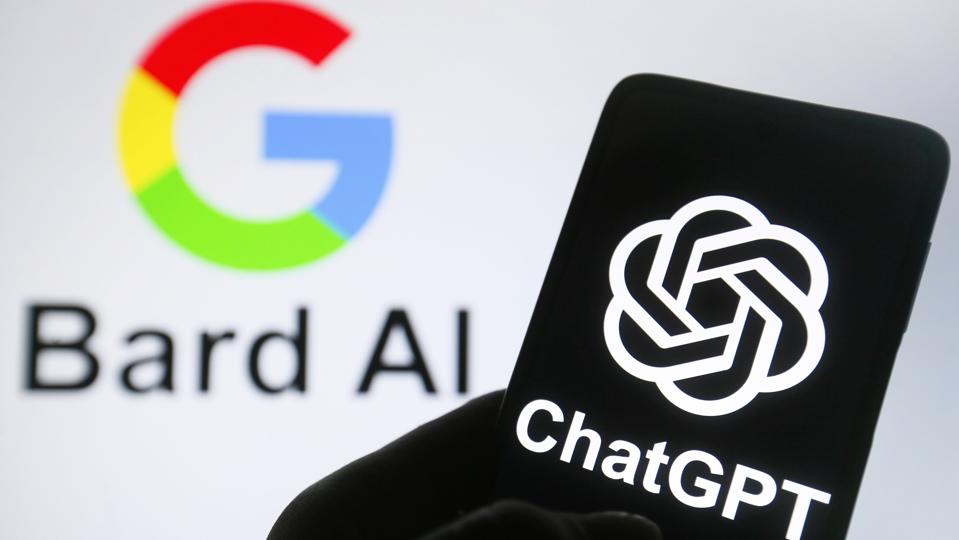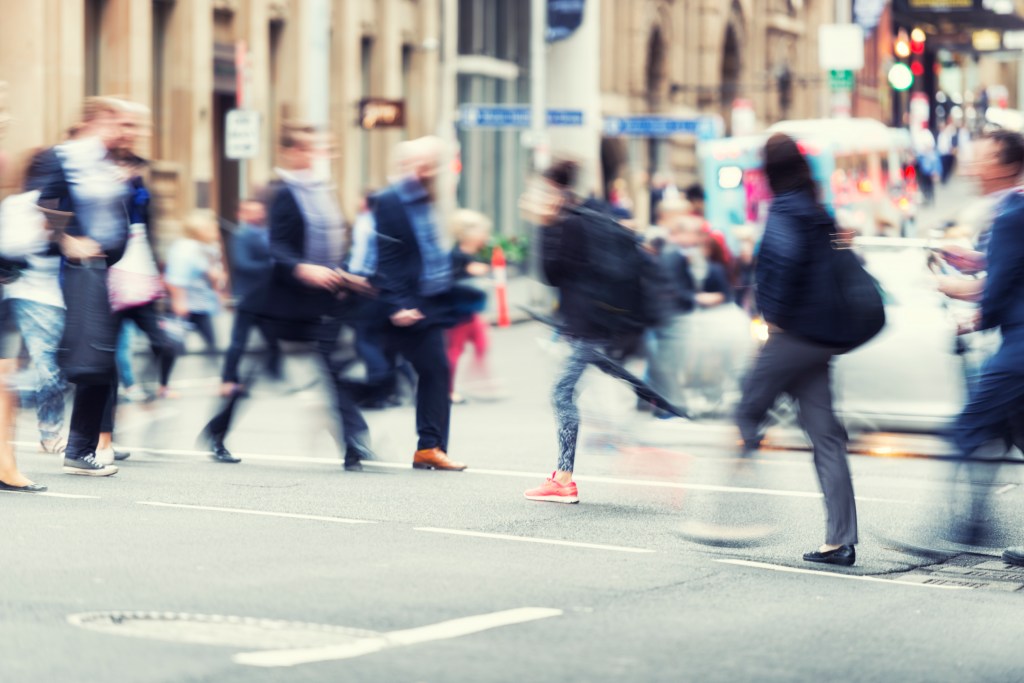Since the release of powerful AI tools ChatGPT and Google’s Bard, discussions about whether “robots” will replace humans have grown, and studies show some jobs—surprisingly, some traditionally white-collar work—may be heavily impacted.

ChatGPT logo is seen on a smartphone with a Google Bard AI logo in the background.
SOPA Images/LightRocket via Getty Images
Key Facts
Generative AI, a form of artificial intelligence capable of creating text or other content in response to user prompts, has quickly gained popularity following the public launch of OpenAI’s ChatGPT.
Since its November 2022 release, people have used AI chatbot ChatGPT for an array of this, including writing college-level essays and generating code.
The AI race heated up after Google released Bard on March 21, a ChatGPT competitor and a separate entity from the company’s Google search engine.
A recent report from Goldman Sachs estimates around 300 million jobs could be affected by generative AI, meaning 18% of work globally could be automated—with more advanced economies heavily impacted than emerging markets.
The report also predicts two-thirds of jobs in the U.S. and Europe “are exposed to some degree of AI automation,” and around a quarter of all jobs could be performed by AI entirely.
Researchers from the University of Pennsylvania and OpenAI found some educated white-collar workers earning up to $80,000 a year are the most likely to be affected by workforce automation.
According to the report, jobs in agriculture, mining and manufacturing are the least exposed to generative AI, while jobs in the information processing industries, like IT, are the most exposed because jobs that use “programming and writing skills” are more closely related to GPT’s capabilities.
Generative AI isn’t perfect, both OpenAI and Google admit their program sometimes gives incorrect responses and has other flaws, like ChatGPT’s knowledge base that ends in 2021, and Bard’s limited conversation retention.
Related
Jobs Most Impacted
- Finance and banking: Banks have already begun incorporating AI into their business models. 56% of banks claim they’ve implemented the technology into their business domains like management, and 52% claim they’ve used it for revenue generation, according to Cambridge Centre for Alternative Finance and the World Economic Forum. Abhijit Bose, a Capital One senior vice president, told the Washington Post AI will potentially “monitor transactions” to give detailed financial advice on saving and spending. Morgan Stanley has begun using OpenAI-powered chatbots to organize its wealth management database, helping advisers pull up data and research more efficiently. The World Economic Forum also predicts AI will bring three changes to the finance division: job cuts, job creation and increased efficiency. In addition, they estimate by 2027, 23% of jobs in China’s financial sector will be replaced by AI.
- Media and marketing: Kristian Hammond, chief scientist of Natural Sciences told the BBC in 15 years, “90% of news will be written by machines.” Natural Sciences has a software called Quill, an AI paraphrasing tool that writes company reports ahead of earning announcements. German publisher Axel Springer announced in February plans to transition into “digital only,” which includes job cuts in favor of “modern technology” and automation. Reporters for different media outlets like Business Insider, CNET and CNBC have used ChatGPT to write news stories, though they have often been criticized for containing false information. In January, BuzzFeed CEO Jonah Peretti announced the company would rely on ChatGPT to personalize content and enhance quizzes, much to the employees’ dismay, according to the Wall Street Journal. In the marketing world, 84% of marketers reported using AI in 2020, a stark jump from 29% in 2019, according to Salesforce research. High-performing marketing teams averaged around seven different uses of AI and machine learning in 2020, and over half planned on increasing their use in 2021, the report also claims.
- Legal services: An attorney used ChatGPT to publish a 14-page legal paper published in Social Science Research Network on a plethora of prompts, including creating a contract, explaining why the Supreme Court’s decision on same-sex marriage shouldn’t be appealed and developing deposition questions. The AI bot has the potential “to address access to justice questions” and make legal services available to those who can’t afford it, Andrew Perlman, the author of the paper and a Suffolk University Law School Dean told Reuters. Low-income Americans don’t get enough or any legal help for 92% of their civil legal problems, according to a 2022 report by Legal Services Corp. Some have already begun incorporating AI into legal service, like startup Lawgeex, which has a service that reads contracts faster than, and what they claim to be more accurate than humans.

Jobs Least Impacted
- Manufacturing and factory workers: This industry has been undergoing automation for a while, with General Motors credited as the first major manufacturer to implement robotics in their assembly lines after the introduction of UNIMATE in 1961. However, generative AI may speed up the process. For example, Elon Musk unveiled the Tesla Bot, or Optimus, an autonomous android made to replace humans in dangerous, repetitive jobs. Musk plans to place these bots in his Tesla factories and eventually expand to millions around the world. According to an MIT and Boston University report, AI is expected to replace as many as two million manufacturing workers by 2025. “Our evidence shows that robots increase productivity,” the researchers said. A Chinese factory in Dongguan City replaced 90% of its workforce with machines, resulting in a 250% increase in productivity and an 80% decrease in defects. A job that took 650 human workers to complete now takes about 60 robots and 60 humans, the company claims.
- Agriculture: According to the U.S. Department of Agriculture, in 2021 there were 21.1 million full- and part-time jobs in the food and agriculture sectors, making up 10.5% of the labor force. Agriculture is considered one of the world’s oldest professions and has stood the test of time, lasting through four separate industrial revolutions. According to the Washington Post, many small farms don’t produce enough profit to invest in more machinery, though larger farms have already begun the process of automation for strenuous tasks. In the U.S., family farms make up 98% of all farms, with a majority being small family farms that operate about half of the country’s farm land. However, the National Institute of Food and Agriculture does fund AI research, education and extension activities in the areas of natural resources and environments, agricultural systems and engineering and economics and rural communities.
- Healthcare: A study published in the International Journal of Health Services found on average, psychiatrists spend 20.3% of their day on paperwork, followed by internists and general practitioners at 17.3%. Mundane administrative tasks like this can be automated, but other areas probably won’t need AI. David Dranove, a professor at Northwestern University’s Kellogg Institute told the Kellogg Insight most adults want to hear about their health from a human, and there’s “a need for compassion…that AI is unable to contribute.” An Oxford University report predicts medical transcriptionists, medical records, medical secretaries and health information technicians are the most likely jobs in the field to be automated, not actual providers. This extends into mental health as well—the Washington Post has tried and failed at creating an AI version of infamous psychologist, Sigmund Freud.
This article was first published on forbes.com



